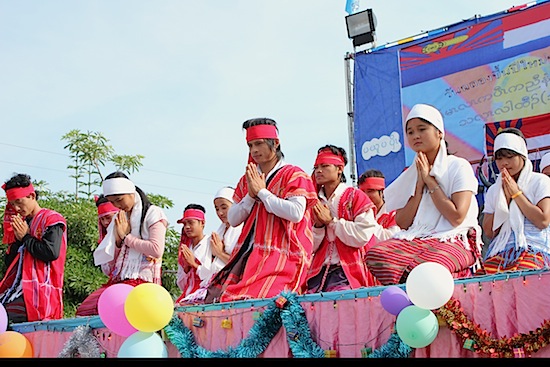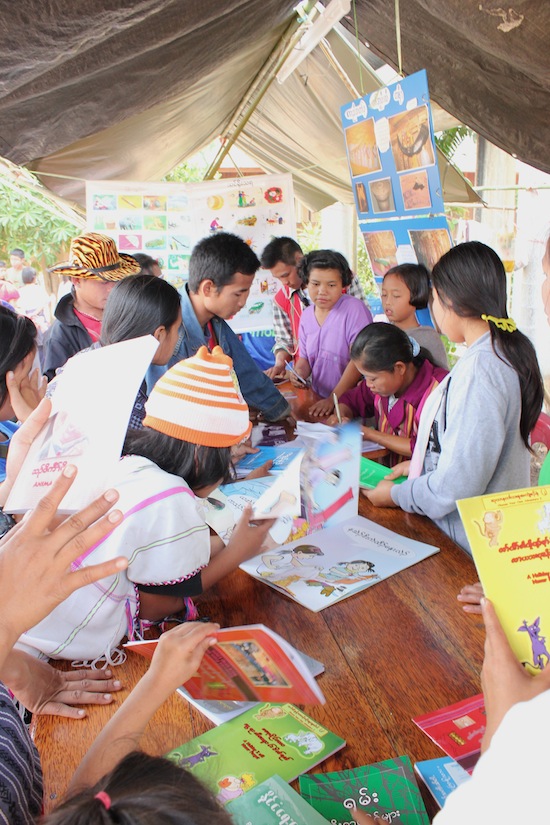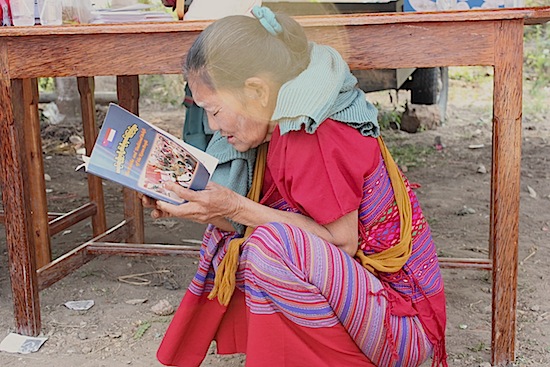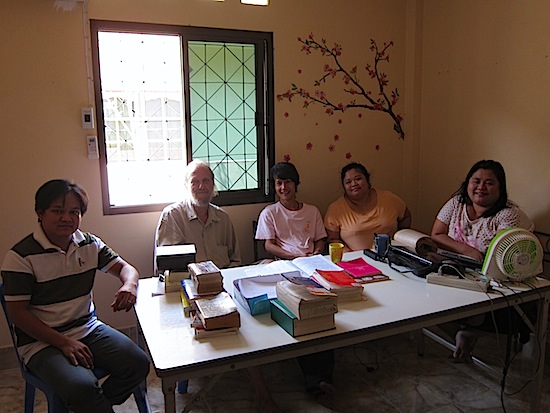It was a frigid winter day in the US state of Vermont when I first met with a recently resettled refugee family back in 2008. The resettlement program had told me they were Burmese, so I was confused when only one 17-year old family member could understand what was written in an English-Burmese phrasebook. I soon learned how they were part of the ethnic Karen minority, displaced by the world's longest-running civil war.
The family of five fled their home village in the mountainous Burma-Thailand border region 10 years earlier when it was attacked and torched by the Burmese military. With a two-year-old in tow, they escaped to Thailand by way of a dangerous path through the jungle, travelling only under the cover of darkness. If the Burmese army had caught them, they almost certainly would have been put to forced labour, possibly as landmine detectors, or shot on sight.

Young Karen take part in cultural activities near Sangkhlaburi, Thailand.
Thousands of Karen have met tragic ends like these after grievances with Burma's central military government unravelled into an all-out armed struggle following World War II. The conflict has persisted in some form to this day, and despite recent positive reforms in Burma, human rights abuses by the military continue against several of the country's many ethnic minorities.
After reaching Thai soil, the family were placed in a refugee camp in the far western reaches of Kanchanaburi province. They were among the thousands of refugees who have sought safety in Thailand after the Burmese government launched increasingly brutal military offensives against the Karen beginning in the late 1980s. These attacks toppled much of the Karen State, a border area and home to the Karen that had been precariously controlled by the Karen National Liberation Army (KNLA), the military wing of the Karen National Union (KNU), since the 1950s.
Today, some 160,000 refugees from Burma -- Karen but also the Karenni, Mon and Kachin -- live crowded into 10 camps along Thailand's northwestern border. After a 10-year wait, the family in Vermont were among the lucky few to be resettled to the West each year.
In the same league of necessities as warm clothes and food stamps, the family was in urgent need of English skills, and the only Karen-English resources available were from the website of Drum Publications. Through Drum, I was able to download an extensive Karen-English dictionary that proved to be an instrumental aspect of the family's successful resettlement over the next few years.

There's no shortage of enthusiasm for the Karen language books.
Drum's roots came about in 1998 when an exceptionally bright young Karen woman, Pawsayhtoo, was instructed by the KNU to translate English materials into Karen. With minimal funding, she set up a touch-and-go operation in Kanchanaburi and was joined in 2001 by Tim Moffatt, an American expat who made up for his lack of Karen language skills with a strong desire to help the Karen people.
Assisted by Tim and a few Karen-English translators, Pawsayhtoo put together Drum's first Karen-English picture dictionary. Up until this point, the only English that had been translated into Karen aside from information pamphlets like "How to Avoid Malaria" was a Bible, a small dictionary and a thesaurus created by Methodist missionaries in the 1800s. In time, Drum produced the Karen-English dictionary with 8,000 headwords that found its way into the hands of the resettled family in Vermont along with many other Karen around the world.
Drum faced an uphill climb to get its books distributed to refugees within the camps, which required cutting through the bureaucratic layers of major aid and resettlement organisations. Funding was thin on the ground. Tim recalled how translators "would sleep in the office and get by on 300 baht of pocket money a month". Yet rather than giving up, the group increased its efforts and produced a range of books in Karen covering topics as varied as health, agriculture, Aesop's Fables and traditional Karen ghost stories.
In those days, Tim reflected how a sense of urgency to preserve the Karen language and culture drove the young team. "The language was dying," he said, a result of the Burmese government's ban on all education and publishing in ethnic languages. Men and women risked their lives by carrying 20 kilos of books for days while dodging landmines and Burmese soldiers to reach Karen villages on the Burma side of the border. The fear of being discovered by the Burmese was so pronounced that, as Pawsayhtoo told us, many villagers "dug holes in the ground and buried the books".

Today, the Karen have relative freedom to read their own language.
Eventually, Drum secured consistent funding from international aid groups that recognised the far-reaching positive influence the work could have. After a long and frustrating process, Drum also succeeded in getting its books officially distributed within the refugee camps.
The group has to date published more than 250 unique titles while also sending out quarterly journals for Karen children. More than 120,000 books were distributed either by hard copy or electronically in 2012. Pawsayhtoo is currently working with three new translators on Drum's most involved project yet -- a Karen-English dictionary with more than 30,000 headwords. It's expected to be finished by the middle of 2013.
Meanwhile, with no previous web development skills to speak of, Tim has created what is by far the most extensive Karen language resource on the web. All books from Drum as well as most Karen publications from other groups can be downloaded from the website, and a searchable database yields detailed results for specific key words and phrases in either Karen or English. Drum staff also make themselves available to speak with resettled refugees face-to-face via Skype.
While Karen-English resources are important, another pivotal goal of Drum is to "promote the empowerment of the Karen people to contribute towards maintaining, protecting and developing manifestations of their culture, language and literature". Drum's annual Karen language story-telling competitions have sparked a renewed passion for reading and writing in Karen communities. The best original works are published by Drum, and many authors go on to have careers as writers and teachers, ultimately inspiring the next generation of Karen to preserve and develop their once endangered culture.

The current Drum team from left to right: Hsamulei, Tim, Wayldee, Paula and Pawsayhtoo.
Looking to the future, team Drum feels that they may soon be able to distribute Karen language books within Burma itself. The Burmese army and Karen military factions are currently in a ceasefire, and while uncertainty persists, some positive steps have been taken by the reformed Burmese government towards bringing stability and a fragile sense of peace to the region. Karen can now travel freely, the Burmese censorship board has reduced restrictions on publishing in ethnic minority languages, and according to Tim, the legalization of teaching in ethnic languages is within reach.
A Drum staff member of six years, Hsamulei, told us that life in the villages has so far improved only slightly for the better, "but we're hopeful" that lasting peace will be reached. In the meantime, Drum Publications will continue its work of preserving Karen culture while expanding minds and keeping hope alive for Karen people the world over.
If anyone would like to support Drum's work, you can do so securely and directly through the Drum website's donation page, and also generally by spreading awareness on the plight of ethnic minorities in Burma.
Sincere thanks to Wayldee of Drum Publications for allowing us to use his photographs.